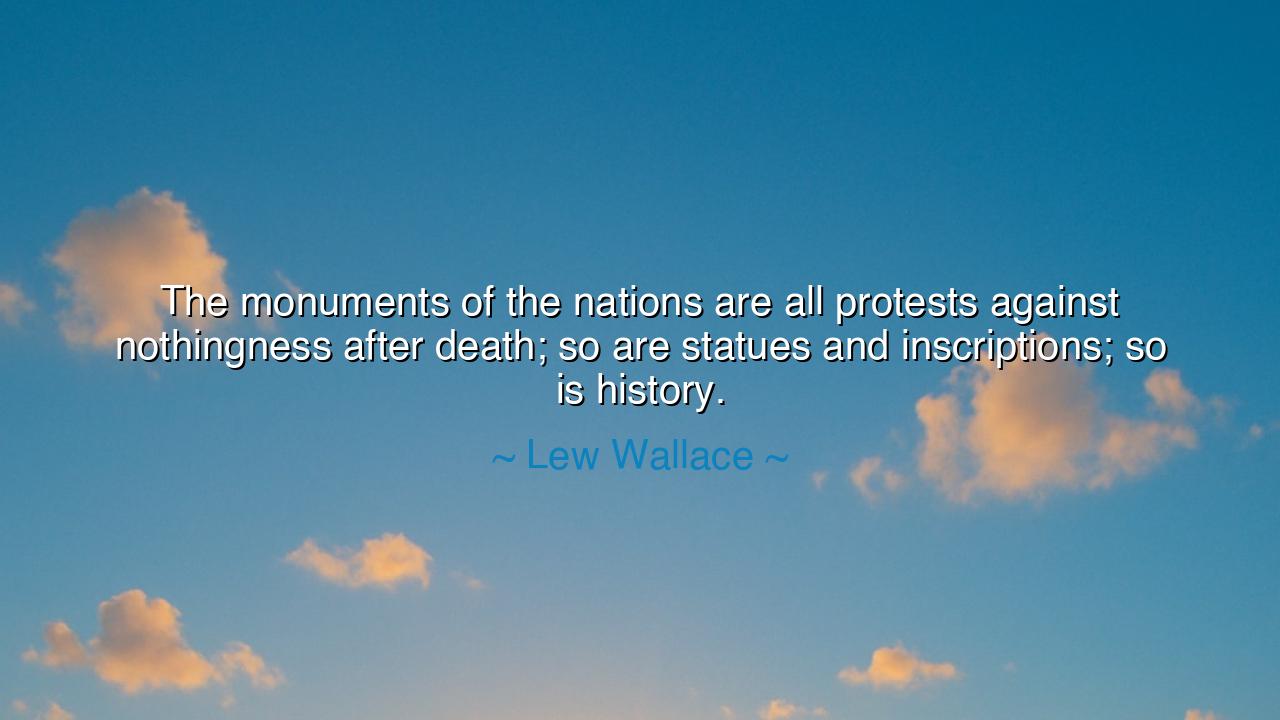
The monuments of the nations are all protests against nothingness
The monuments of the nations are all protests against nothingness after death; so are statues and inscriptions; so is history.






In the haunting and reflective words of Lew Wallace, the soldier, statesman, and author of Ben-Hur, we hear the voice of one who has stared into the abyss of time and sought meaning beyond its silence: “The monuments of the nations are all protests against nothingness after death; so are statues and inscriptions; so is history.” These words resound like the tolling of an ancient bell—solemn, profound, and eternal. Wallace, who lived through war and creation alike, understood that humanity’s greatest works—the temples, the statues, the chronicles of nations—are not merely records of triumph but cries of defiance against the void. They are our rebellion against oblivion, our refusal to accept that death and decay are the final words of existence.
The origin of this quote lies in Wallace’s deep spiritual contemplation. Though he was a man of battle, commanding troops in the American Civil War, he was also a man of faith and doubt, a seeker who wrestled with questions of the soul. His most famous work, Ben-Hur: A Tale of the Christ, was itself born from his search for proof of the divine—a journey from skepticism to belief. In speaking of monuments and history as “protests against nothingness,” Wallace gives voice to this inner war: the struggle of humankind to create meaning in a world where death seems to erase all things. For every statue erected, every name carved in stone, every page of history written, he saw a human heart crying out: I was here. I mattered.
This yearning to endure beyond death is as old as civilization itself. The pyramids of Egypt, rising from the sands like frozen prayers, were built not merely to house the dead, but to proclaim eternity. Each block, each hieroglyph, defied the silence of the grave, insisting that Pharaohs would live forever in stone and story. Yet time has shown the irony that Wallace perceived—the sands swallow empires, the winds erode names, and even the greatest monuments fade. But still, humanity builds. The act itself becomes holy, for though we know our works will not last forever, the act of creation declares that we will not yield to nothingness. To create is to protest; to remember is to resist.
History, too, is part of this protest. For what is history but the memory of those who refused to be forgotten? Each chronicle, each tale of kings and poets, is humanity’s answer to the finality of death. The historian, like the sculptor, carves names into the eternal record, giving shape to the fleeting. When Wallace says that history itself is a protest against nothingness, he reveals that every story ever told is an act of resurrection. To tell of those who lived and died is to give them a second life within the hearts of the living. The written word becomes the soul’s monument, one that endures longer than marble or bronze.
Yet within Wallace’s words lies not only admiration for humanity’s defiance, but also a quiet melancholy. For all our monuments, he reminds us, we cannot escape mortality. The cities we raise will crumble, and even our memories will fade in the far reaches of time. But in this truth, there is no despair—only dignity. For it is in the struggle against oblivion that the nobility of humankind is revealed. We are creatures who know our end and yet build as though we will live forever. This, Wallace suggests, is our greatest act of courage—to live meaningfully in the face of impermanence.
Consider the example of Ozymandias, the ancient king immortalized by Shelley’s poem. His colossal statue, once meant to proclaim his might, now lies broken in the desert, his empire long forgotten. “Look on my works, ye Mighty, and despair!” reads the inscription—and yet, it is not the king who endures, but the poet who told his tale. Here lies the paradox that Wallace unveils: while the monuments may fall, the impulse to create them, the spirit that drives humanity to remember and to be remembered, transcends even time itself. Our protest against nothingness is not in the permanence of stone, but in the eternal fire of the human soul.
Thus, the lesson of Wallace’s words is both humbling and exalting. We cannot escape death, but we can infuse life with meaning. Every act of love, every work of art, every truth spoken with courage becomes a monument of its own. You need not build pyramids or carve statues—your kindness, your words, your integrity are protests against nothingness, testaments to a soul that refuses to be erased. To live well, to live truthfully, is to write your own inscription in the eternal ledger of being.
And so, my child, take this teaching into your heart: live as your own monument. Do not wait for stone or history to speak your name. Let your deeds, your compassion, your courage be the record that defies oblivion. For though time may one day silence your voice, the resonance of your soul will echo through the hearts you’ve touched. This is the truest protest against nothingness—not the marble that crumbles, but the spirit that endures.






AAdministratorAdministrator
Welcome, honored guests. Please leave a comment, we will respond soon